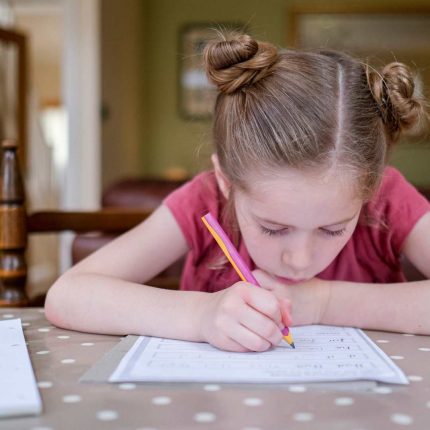Part 2 of a three-part series on handwriting.
Guest post By HollyOnHandwriting
“For today’s journal entry,” the homeschool parent starts, “I want you to describe our nature walk. Write about the plants we’ve been studying and draw a picture of an animal we saw.”
We would love for our kids to leap at the opportunity to write about their experiences, to enthusiastically whip out their notebooks, and let their thoughts flow onto the paper with ease. But for many, the assignment is met with heavy sighs, sometimes moans, and eye-rolls. Why is writing so difficult for some kids? In part one of this three-part series, I suggested that the most basic aspect of writing to consider is a child’s ability to transcribe –or the physical act of getting their thoughts onto paper. The child who struggles at this base level will have a hard time advancing their writing abilities. (You can read the whole article here.)
Possible Problem: Trouble Spelling
Here in part two, we look at another writing fundamental that interrupts what should be a flow of thought onto paper, namely, spelling. Like handwriting kids need to be able to spell in order to get words onto paper easily. We are aiming for flow. If water running through a pipe gets stuck, we naturally look for whatever might be clogging the pipe and remove it. If a child’s working memory (that limited brain function that is actively working on a task in a given moment) is consumed with basic writing skills, it does not have the capacity to work on more complicated aspects of the writing process. The pipeline from head to hand is clogged. By helping our kiddos become good spellers, we free up their minds to be able to express their thoughts more easily and clearly. How do we do that…especially if our child is currently struggling with spelling?
Volumes have been written on spelling, how to teach it, how to address spelling problems, and why a child might have problems spelling correctly, but here we will take a look at three aspects of learning that will get to the heart of spelling skill. Broadly speaking language is acquired by seeing, hearing, and writing. Each of these learning modes as they relate to spelling is addressed below.
Building Their Word Bank: Vocabulary
Reading and writing skills strengthen each other. Therefore, to improve writing skills- specifically spelling ability- read well and often. Your student “collects” vocabulary by hearing and seeing words in their environment, so increase the rich literature in your student’s day. Share stories together. Broaden the genres and topics that your child reads. And, importantly, reduce the amount of scrolling through short video clips and written junk coming into your student’s life through smartphones and other internet devices. Such input trains their brain for short attention, shallow thinking, and could be contributing directly to their writing difficulties.
Another way to build your student’s vocabulary and improve their spelling ability is by having your student read aloud. Choose great books written at varying reading levels. Have your student read aloud every day to improve their fluency, visually connect to written words, and audibly hear their pronunciation. Reading aloud requires them to decode words being mindful of each sound and accent. It requires them to adjust their speed of reading and regulate their cadence. Listening to them read aloud will help you identify problem spots so you can fine-tune your instruction and support. Reading— especially reading out loud— will increase their vocabulary and help them make the sound-to-symbol connection which will improve their ability to spell words.
The Sight-Sound Code: Phonology
A phonogram is one letter or a combination of letters that represent one sound. For example, c-a-t would be considered three phonograms—the three sounds /c/, /a/, and /t/; whereas the three-letter combination, “igh,” is one phonogram pronounced /ī/ as in the word “right.” When students are taught to “sound out” letters, they are learning to decode words. Systematic instruction of English phonograms is imperative for students struggling to spell. (For an easy-reference phonogram app, download the “Phonogram Sounds” app by All About Learning Press.) Without this, they do not have the tools to even try to spell words.
Spelling requires the student to read inside out, so to speak. They need to be able to hear the word in their head, break the word into individual sounds, and reproduce those sounds using letters. If your student struggles to spell, it helps to go back and review, reteach, and recall the code. Teach the phonograms as you might teach a list of spelling words—systematically— reviewing, repeating, and using the phonograms in words. (I can recommend All About Spelling if you need a place to start.)
From Head to Hand: Orthography
We can think of reading as words coming off the page and writing as words going onto the page. While intimately related, the two processes require different cognitive abilities. Correct spelling or “orthography”(the Greek root “orthos” meaning “correct” and “graphia” meaning “writing”) is governed by rules and patterns that help us use language effectively and is necessary for clear communication. The ability to write is a test of one’s language skills; learning to write is complicated. In order for the hand to produce a word, the brain must either pull it from memory or work to decode it using the rules and patterns already established in the student’s brain. You can see why building vocabulary and understanding the English phonological code are important to reproducing words on paper.
Let’s talk now about a direct way to learn and reinforce the spelling of words. You can use a list from your curriculum or generate your own list from your reading material. Make learning and practicing words a regular and frequent part of your week.
Help your student through the following steps:
Step 1: Read the word out loud (You wouldn’t believe the number of students I’ve helped who
were trying to spell words they couldn’t even read.)
Step 2: Sound out the word while pointing to the letters that represent each sound
Step 3: Write the word by looking at it and saying each sound (not the letter, but the sound)
Step 4: Cover the word and write it saying each sound in the word as you write
Step 5: Check against the previous version to make sure it was spelled correctly
Step 6: Read the word out loud one last time
One More Thought on Writing
Writing the words by hand is a unique and important connection to the written word. Letter formation provides a kinesthetic connection to language, reinforcing the visual and phonetic aspects of words.
Give students the freedom to look, practice, and try again. Teach them to test themselves, but do not pressure them to learn it within a short time frame. Give them ample opportunity to use the words in other contexts. Assure them that the ability to spell is developed over years of exposure to and practice of the language. How we form, order, and represent thoughts in code is a marvelous human feat that may take time. Look at Squiggle Squad for a unique, effective, fun approach to letter formation instruction.
More about the Author Holly Britton. The Squiggle Squad’s program designer, Holly Britton, M.Ed., is a curriculum and instruction specialist with teaching experience in all grades K-8. She is an author and conference speaker and a former home educator of four now-adult children. Holly brings over 22 years of private and public education experience to this program. Holly relishes time with her friends and family including her horse, Shasta.
More Articles on Homeschool Handwriting
What if My Kid Hates Writing Part 1
Handwriting: An Indespensible Learning Tool
Teaching and Improving Handwriting Skills
How and Why We Teach Cursive Handwriting
Why Your Teens Should Know Cursive Writing
Latest Posts

Guest Post by Gabriel Morse For several years, I sat for long hours every day behind one of those battleship gray desks in a windowless, dull, gray office. The pay was enough to take care…
Read more >
This post is sponsored by Little Monsters Universe. I'm Tina Salmanowitz, an advocate for homeschooling and science education. With over a decade of experience as a science educator (in class…
Read more >
This post is sponsored by Time4Learning. Before the pandemic, it was business as usual for Boca Raton resident Nikki Warris. Her two daughters, 5-year-old Natalie and 8-year-old Lexi were…
Read more >



